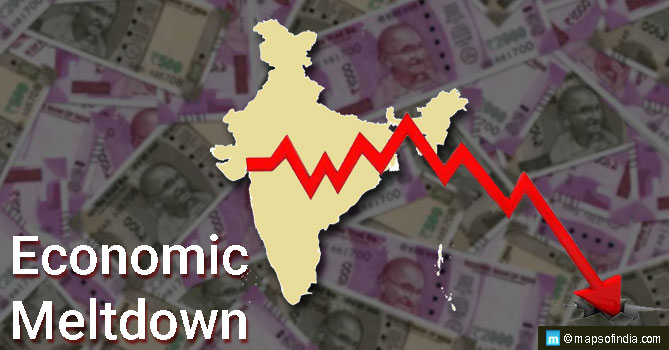
Most economic parameters used to judge the state of the economy to the point of an economic slowdown in India. It’s far more significant than the government would like us to believe. Almost all core indicators of growth are in the negative or just barely positive, a far cry from the heydays of high growth witnessed from 2004 to 2010.
After hope, the bubble
The year 2019 has been its weakest year since 2014 when PM Narendra Modi came to power riding on the back of hope for the biggest development plans the country had ever seen.
Into its second term after winning a massive mandate in 2019, the NDA government finds itself in the middle of India’s worst-performing years in a decade.
Low Growth Rate
As per the government data, in Q1 of 2018-19, the economy was growing 8 per cent. By Q2 of 2019-20, it has crashed to 4.5 per cent with little signs of improvement in Q3.
Falling tax revenues
Falling tax revenues is tying the government’s hands. Direct Tax Revenues (after adjustment for inflation) have fallen from 16 per cent in 2017-18 to 10 per cent in 2018-19 and falling to zero by Q2 in 2019-20.
Falling exports
That’s not all. The export growth rate got down from 9 per cent in 2017-18 to 7 per cent in 2018-19, and a negative of 1 per cent in Q2 of 2019-20. Capital goods imports, another indicator of a growing economy, stands at negative 10 per cent.
Unsold real estate
The top eight cities driving the urban real estate sector in India recorded sales of INR 2 lakh Cr in 2019 but held INR 8 lakh Cr worth of the unsold real estate. It means INR 6 lakh Cr worth of money continues to remain stuck in the economy with no immediate relief coming.
Fall in commercial lending
In 2018-19, the collective commercial lending to the real estate sector stood at INR 22 lakh Cr. In 2019-20, the loans released to the sector by the end of Q2 is around INR 1 lakh Cr.
So, while there are no buyers of completed homes, the real estate companies don’t have the money to complete a large number of unfinished projects.
Rise in NPAs
The banks and NBFCs which lent to the sector have massive Non Performing Assets (NPA) on their books. With low tax revenues, the government does not have the money to bail out the real estate sector, which also happens to be a significant creator of jobs. In many ways, it is reminiscent of the real estate bubble during the 2008 Sub-prime crisis in the United States.
All core indicators point to a struggling economy, and yet the stock markets are rising like a blindfolded ostrich, oblivious to reality.
All defendants of the government, within and outside, who remained vociferous on India’s growth story in the run-up to the 2019 elections, are now grudgingly accepting there is a problem, albeit temporary.
India’s data credibility at stake
The data coming out of the NSSO and other government sources on the economy is questionable as India’s credibility takes a hit. In its October 2019 Report, the International Monetary Fund (IMF) has spoken on the need for the country to improve the transparency of the actual performance of the economy.
In November this year, Moody’s lowered India’s GDP forecast for 2020 to 5.6 per cent, from the earlier projection of 5.8 per cent made in October.
In which sectors are the slowdown most visible?
– Employment: New Job creation is abysmal.
– Farm incomes: have fallen
– Auto: sales have fallen; over 300 vehicle dealerships have shut down
– Real Estate: Highest levels of unsold inventory across cities
– FMCG: Most companies are reflecting lower Y-o-Y sales
– Bank NPAs: At its highest
– Core sector: Performing below previous years
What’s the biggest reason behind the economic slowdown?
Two main reasons:
– Lack of consumer demand
– Low tax revenue
When 1.21 Billion people reduce or stop buying any item, it has a cascading effect on the economy. When the consumer has cash in hand, the person spends on goods and services to meet daily requirements.
All stakeholders in the economic value chain benefit from a rise in consumer demand, which in turn triggers purchases of raw materials to produce goods needed to fulfil that demand. It’s true for farms, factories, and service providers.
Higher spending by consumers means higher tax revenues for the government. It enables the government to spend more on social welfare and development schemes, increase overall expenditure, and increase lending to priority sectors or where funds are needed most, all of which spur economic growth in the country.
Let’s take a homemaker as an example.
Daily, the homemaker buys fruits, vegetables, milk, eggs, and bread. The homemaker requires groceries like toothpaste, soap, shampoo, cooking oils, etc. for the daily domestic chores and are purchased on a weekly, fortnightly, or monthly basis.
Then there is shopping for clothes, going out to restaurants or ordering food from outside, weekend movies at the theatre, parties, etc. The homemaker and the family also spend on home furnishing, repair, and replacement of household items and fixtures.
There are other recurring expenses like children’s school and college fees, child maintenance, house electricity, water, and phone bills, house help salaries, society maintenance charges, etc.
Then, there is travel for work or leisure. It involves tickets, hotel bookings, and spending on food and services in the area of visit.
The homemaker and the family get to spend on all the above only when the income generator has cash in hand. Money comes in by way of salary or profit from some activity.
Consumer income forms the backbone of the economy and is its biggest driver. When consumer spending falls, the economy suffers. When it rises, the consumer spends more, and the economy grows.
But, what if the economy isn’t doing well. It results in job losses and salaries not rising in proportion to the rising cost of goods and services mentioned above. Either way, it forces consumers to cut back spending, which in turn slows down the economy.
It explains how the country got here.




